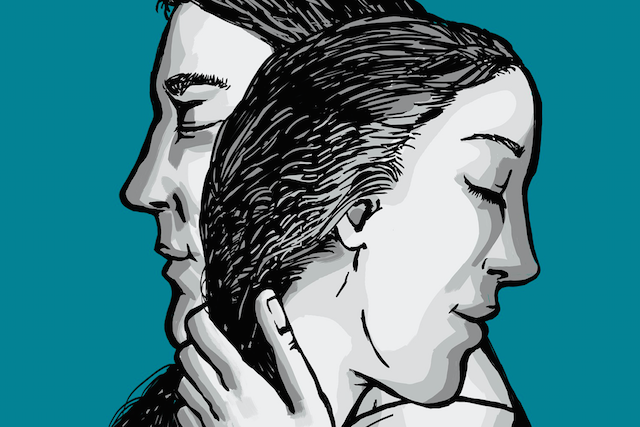
“People are lonely because they build walls instead of bridges.” ~Joseph F. Newton
“Oh my God, Mom…” she said with a verbal eye roll.
“What?” I responded, sure that I had said too much or overshared like I normally do.
I can’t recall what my daughter and I were discussing openly about while standing in line at the grocery store checkout, but I do remember the girl ringing us up laughing and saying we sounded just like her and her mom.
I paused, unsure what that meant.
“Is this what a healthy mother/daughter relationship sounds like?” I questioned to myself. It was a completely foreign concept to me.
I wanted to create a strong bond with my daughter, but my own relationship with my mother was dysfunctional and boundary-less when I was a child, leading me to overthink everything when it came to creating a relationship with my daughter.
My mother had significant mental health challenges, which eventually led to her death by suicide.
I had no idea what healthy felt like.
Insecurity plagued me when it came to connecting with my daughter. Was I giving her too much or not giving her enough? Did she trust me? Did she feel comforted by me? Was I too lenient? Was I too distant?
It was hard to tell when the voices of doubt chimed in.
I’ve watched other moms with their daughters since I was a young girl. I wasn’t exactly sure what normal was, but I knew it was not telling their daughters how depressed they were or talking through their marital issues. I knew it was not asking their daughters for advice and relying on them to feel good enough to get out of bed by midday.
I knew my relationship with my mom was different, but it was the only one I had. My normal was gripping codependency and making sure she was okay so she would be there the next day.
I didn’t want that relationship with my daughter. I wanted her to feel whole and complete and deeply loved without having to take care of another human being to feel it.
My journey into motherhood was far from easy. With few role models and almost no experience with children, I felt like I had nothing to go on besides instinct alone. And my instincts were part of my problem. I couldn’t always hear them.
When a child grows up in a volatile environment during their early development, they learn to distrust connection. When what feels comforting and loving one minute can turn to betrayal and rejection in the next, trust in others does not come easily.
A human’s natural inclination is to want connection, but inconsistency or harm against a person creates a fear in that same connection. When this happens during early development, the child learns to fear what it also deeply desires—which develops into an adult who is quietly terrified to experience and trust reciprocal love.
The only way I knew how to create that healthy connection was to look deeply into myself and be aware of my patterns and how I was passing them on. And so I observed—a lot.
I observed other families and the way mothers spoke to their daughters. I observed the way the daughters responded to their moms. I watched what drew my daughter in, and I watched what pushed her away.
I learned to listen without speaking (which is absolute torture when codependency feels like home), and I learned to ask more questions instead of giving unsolicited advice. I’m still learning, and most likely will be for the long haul since old habits die hard.
But it wasn’t just that. It wasn’t just learning how to respond to normal discomfort when someone I love was uncomfortable. It was learning to respond to normal discomfort when I was uncomfortable. It was learning to not shut down and begin to emotionally detach when insecurity started to get loud.
Raising my children is one of the biggest challenges I’ve had to navigate with these embedded fears. To give birth to a part of you and know your job is to let this soul grow into themselves while they slowly leave you a little more each day. Pulling them close to me to feel safe and loved and teaching them to leave all at the same time. It’s like one long continual dance of love and grief.
My daughter started college this year and I knew it was going to be tough when she moved on campus, but I had no idea the depth of the grief I would feel. It’s not logical. And the logical part of me likes reason and boxes to put my feelings in. I cognitively knew it was temporary, but my body did not know. It stores memories of every loss and every time I’ve felt left behind, and it was eager to remind me.
“Life will never be the same again. It’s over.”
And that is true. But until those old pangs of grief retell their stories without being dismissed and reprimanded for being dramatic or “too much,” I could not see that the new life may even be better than the one before.
When I let myself experience the sad and angry feelings without reacting to them, they moved through me faster and I could see what I needed to stay connected.
I requested we have small doses of consistent communication during the beginning stages of her being gone so I could show my fears they were unwarranted. We sent pictures on snapchat most days, and it was just enough to feel connected without being intrusive. It worked for us and comforted my childhood-driven fear until it passed.
The first time she came home was over a month after she left. Our oversized puppy expressed it best with his big cries and leaping happiness to be with her again. We missed her and our little family felt the absence of her presence in a big way.
The joy of her energy filling our house was immense. To be in my space again and under my care felt like she never left. She was in and out and visiting friends and doing her thing, but her presence was the reassurance I needed.
It felt like the scared toddler in me re-experienced object permanence. Proof that it’s safe to trust that if love walks out the door, it also returns. Maybe not in the same shape or the same way, but it comes back when it’s ready… and maybe it never truly left to begin with.
My little-girl heart, still quietly afraid of loss, was healing.
Fears of re-experiencing old pains and heartache are the norm in the human experience, and the more we understand our fears, the more we can work with them to keep our connections strong and secure. It also helps us to not pass them on to our children, our partners, our friends and family.
Our job is not to silence our pain or our fears. Our job is to invite them to the table, let them speak, let them breathe, and let them share their story to completion. Their interrupted cycle is what keeps them around longer as they impatiently wait to be noticed.
When a fear shows itself through strong surges of emotion (sadness, anger, loneliness, etc.), ask it for more information like you would someone else.
You can do this verbally out loud or write it out. Ask, tell me more about that pain or fear. What does it feel like? Where do you feel it in your body? Does it hurt or feel restricting? Have you experienced this feeling before?
Then ask when was the last time you recall feeling this way. What was happening? Who did it involve? What were you scared of? What was the outcome? What might you be doing right now to avoid that same pain? Is it working?
As you start to uncover the sensations and emotions, ask, what would you tell someone else who was experiencing this same pain? What would you tell a child?
And my favorite question, what is the most loving and compassionate thing you can do for yourself right now?
Questions like these give us the opportunity to feel our feelings without transferring them on to someone else and give them a voice they might not normally have. Our inherent need to be seen and heard is met, and we are not ignoring what is asking to be felt.
The more we let ourselves feel, the more we can hear the voice underneath the feelings once they pass. The quiet intuitive voice who always knows how to nurture us, heal our wounds, and instructs us how to have the courage and ability to have loving relationships with those we care about.
It’s normal to have fear in our connections. It’s part of our experience as humans and often how we learn about ourselves most. But to let those fears dictate the way we connect keeps us from connecting in the ways we truly crave. True intimacy requires vulnerability and a trust that starts within ourselves. The more we are willing to listen to the fears that drive us, the more we are open to the love that feeds us.
What are you really scared of? Let your fears be heard, but let your heart lead the way.
About Lynn Reilly
Lynn Reilly is a licensed professional counselor, master energy therapist, and author of the self-care book 30 Days to Me and the children's book The Secret to Beating the Dragon. You can subscribe to her insights and benefit from her 15-minute trust practices to live more fully on livingwithserendipity.com as well as follow her on Facebook and Instagram.













 Though I run this site, it is not mine. It's ours. It's not about me. It's about us. Your stories and your wisdom are just as meaningful as mine.
Though I run this site, it is not mine. It's ours. It's not about me. It's about us. Your stories and your wisdom are just as meaningful as mine. 